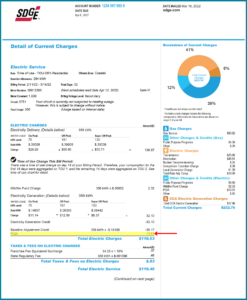Clean Energy Alliance (CEA) aims to help customers to understand their energy bill. As part of this continued education, we’re highlighting San Diego Gas & Electric’s (SDG&E) exit fee called the power charge indifference adjustment (PCIA). SDG&E assesses the PCIA to ensure that customers are charged for the costs of energy contracted by SDG&E. The PCIA is not a new charge and is assessed for all customers, whether you are enrolled in CEA or not. For customers that are not enrolled in CEA, the PCIA is a component of SDG&E’s generation rate. And most importantly, despite the PCIA charge, CEA’s rates remain competitive with SDG&E’s rates. Below are common questions and answers regarding the PCIA and how it affects customers.
Why does SDG&E charge the PCIA?
The PCIA is a charge to ensure both SDG&E and CEA customers pay the above market costs of energy that SDG&E has contracted for.
The adjustment also ensures that customers who do not take service from CEA and remain with SDG&E customers are not impacted by the decision of a customer to purchase their electricity from CEA. Current statute requires that remaining utility customers not experience any cost increase as a result of the implementation of a community choice aggregation (CCA) program.
How is the PCIA calculated?
The PCIA is adjusted and calculated yearly by SDG&E, through a rate setting process at the California Public Utilities Commission. The calculation aims to determine the difference between the actual costs paid by SDG&E and the current market value of those energy resources. In addition to conventional power, the PCIA considers resource adequacy, renewable energy, and other energy attributes that impact the value of the utility’s energy portfolio.
How does the PCIA show up on my energy bill?
 SDG&E Customers: Customers who choose to receive transmission, delivery, and generation services from SDG&E have the PCIA baked into SDG&E’s electric generation rates and the PCIA charge is broken out on the right hand side of the bill under the “Breakdown of Current Charges”.
SDG&E Customers: Customers who choose to receive transmission, delivery, and generation services from SDG&E have the PCIA baked into SDG&E’s electric generation rates and the PCIA charge is broken out on the right hand side of the bill under the “Breakdown of Current Charges”.
CEA Customers: When a customer begins CEA service, the PCIA is a separate line item in the SDG&E Electric Delivery Charges section of the bill.
Do all departing customers pay the same amount?
No, the PCIA uses the concept of “vintaging” to assign different sets of energy contracts to customers based on when they have left SDG&E’s generation service. CEA customers are assigned a “vintage”, based on the month and year the customers left SDG&E utility service. PCIA rates vary between the vintages. The PCIA continues until the last energy contract in that vintage expires, and that group of customers have paid for their fair share of the energy that SDG&E budgeted for them. This is true for all community choice aggregators in California.
Will the PCIA go down every year?
Theoretically, there should be less contracted energy in the customer’s vintage with each passing year. However, other variables affect the PCIA, such as the market value of energy.
As the market value of energy, which is heavily influenced by natural gas prices, goes up, the PCIA goes down, and the reverse also applies. Over time the PCIA will decline.
Why is the PCIA a concern to CCAs?
The PCIA directly affects CEA’s ability to set rates competitive to SDG&E. This is true of all community choice aggregators in California. CEA strives to provide a stable and competitive rate environment for customers and PCIA fluctuations can affect customer bills.
For more information, visit our PCIA Fact Sheet and our FAQs webpage.
